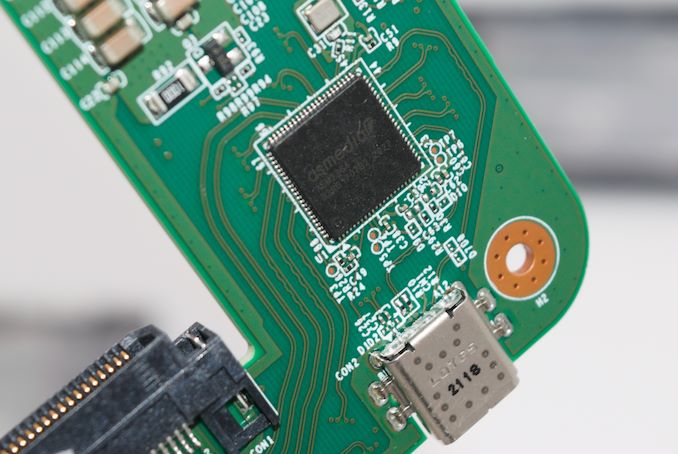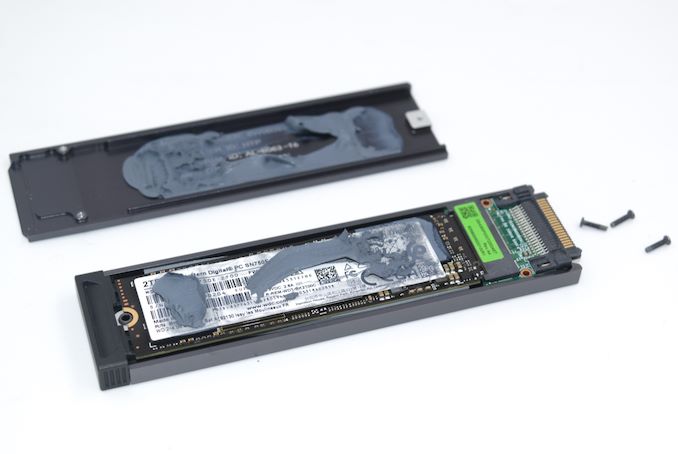
SanDisk Professional PRO-BLADE Portable SSD Ecosystem Review
2024-03-07Western Digital had unveiled the SanDisk Professional PRO-BLADE modular SSD ecosystem in mid-2022 to serve the needs of the professional market. The PRO-BLADE family comprises of three product lines – compact and sturdy NVMe drives (PRO-BLADE SSD Mags), a USB 3.2 Gen 2×2 (20 Gbps) enclosure for the mags (PRO-BLADE TRANSPORT), and a four-bay Thunderbolt enclosure (PRO-BLADE STATION) directly compatible with the mags. The mags are essentially M.2 2280 NVMe SSDs with a custom connector that directly exposes the internal PCIe Gen3 x4 interface, albeit with support for a higher number of mating cycles compared to the native M.2 2280 internal SSD one.
The PRO-BLADE ecosystem targets professionals in the content capture industry involved in multi-user / multi-site workflows. The typical use-case involves the SSD Mags in TRANSPORT enclosures on-site. Different team members can have their own TRANSPORT enclosures across which the SSD Mags may be hot-swapped. The central location with the PRO-BLADE STATION has the ability to ingest data from multiple SSD mags at speeds (Thunderbolt 3) higher than what is possible with the 20 Gbps TRANSPORT enclosures.
Western Digital sampled multiple PRO-BLADE SSD Mags and TRANSPORT enclosures for evaluation. This review takes a detailed look at the internals of the PRO-BLADE SSD Mag and the PRO-BLADE TRANSPORT enclosure, followed by a discussion of the results of putting the 2TB and 4TB combinations through our rigorous direct-attached storage performance evaluation routine. Prior to discussing the value proposition, we also look at the power consumption and thermal profile of the two configurations.
Portable storage drives have evolved rapidly over the last decade. There are multiple high-performance options in different form-factors for consumer and prosumer use-cases. The requirements for professionals involved in the content capture industry had typically been fulfilled using bulky storage arrays based on HDDs. Advancements in flash technology have disrupted this segment also.
Vendors designing bus-powered flash-based direct-attached storage devices need to keep performance consistency, power consumption, and pricing in mind. The ideal device would have high performance consistency (across extended stress periods, as well as workload types), low power consumption, and low cost. In practice, there are trade-offs involved, and the optimization of different aspects are done depending on the target market segment. The content-capture industry is sensitive to performance consistency. Pricing is not usually a major concern, and power inefficiency is usually tolerated as long as the performance is good.
Western Digital offers the PRO-BLADE SSD Mags for standalone purchase in 1TB, 2TB, and 4TB capacities. Users need either the PRO-BLADE TRANSPORT enclosure or PRO-BLADE STATION to enable a host system to use the storage capacity. Users can also purchase one of the four available PRO-BLADE TRANSPORT configurations (the 0TB empty enclosure, or the 1TB or 2TB or 4TB versions which come with a single PRO-BLADE SSD Mag of the appropriate capacity).
The PRO-BLADE SSD Mags have a gumstick form-factor. They are essentially a thermal cladding for a M.2 2280 NVMe SSD with a customized PCIe Gen3 x4 connector. This connector allows for a sung fit inside the TRANSPORT enclosure’s receptacle. The TRANSPORT 2TB package pictured below includes a 50cm. USB 3.2 Gen 2×2 20 Gbps Type-C to Type-C cable along with a warranty guide and an user guide.
Both the SSD Mag and the TRANSPORT enclosure are held together by Torx screws that are simple to take apart. The gallery below presents a closer look at the enclosure and mag design, as well as their internals.
The screws inside the enclosure after taking apart the cladding are normal ones. Both segments of the TRANSPORT enclosure are solid metal with good thermal conduction paths (involving a thermal pad and a raised metal block on the case for the bridge chip).
The enclosure has a stylish and solid feel to it with the ridges on the side giving users additional traction. The recessed nature of the holding end of the SSD mag is also designed keeping the user experience with swapping mags across different enclosures and the PRO-BLADE STATION in mind.
Western Digital utilizes an ASMedia ASM2364 bridge chip under the thermal pad in the TRANSPORT enclosure’s board.
The SSD mag incorporates the Western Digital WD_BLACK SN750E M.2 2280 Gen3 x4 NVMe SSD with plenty of thermal paste ensuring good contact with the metal sides. This SSD utilizes an in-house SanDisk controller along with 3D TLC NAND (BiCS 5?) and DRAM for the flash translation layer.
The combination of the WD_BLACK SN750E and the ASMedia ASM2364 has already been seen in the WD_BLACK P50 USB 3.2 Gen 2×2 PSSD. This combination supports S.M.A.R.T passthrough along with TRIM, as shown in the CrystalDiskInfo screenshot below.
| S.M.A.R.T Passthrough – CrystalDiskInfo | |
 |
 |
The table below presents a comparative view of the specifications of the different direct-attached storage devices presented in this review.
| Comparative Direct-Attached Storage Devices Configuration | ||
| Aspect | ||
| Downstream Port | PCIe 3.0 x4 | PCIe 3.0 x4 |
| Upstream Port | PCIe 3.0 x4 (SSD Mag) USB 3.2 Gen 2×2 Type-C (TRANSPORT) |
PCIe 3.0 x4 (SSD Mag) USB 3.2 Gen 2×2 Type-C (TRANSPORT) |
| Bridge Chip | ASMedia ASM2364 (TRANSPORT) | ASMedia ASM2364 (TRANSPORT) |
| Power | Bus Powered | Bus Powered |
| Use Case | Compact portable SSD with separate TRANSPORT enclosure targeting multi-user / multi-location professional use-cases | Compact portable SSD with separate TRANSPORT enclosure targeting multi-user / multi-location professional use-cases |
| Physical Dimensions | 109.8 mm x 28 mm x 7.5 mm (SSD Mag) 130.4 mm x 71.5 mm x 16 mm (TRANSPORT) |
109.8 mm x 28 mm x 7.5 mm (SSD Mag) 130.4 mm x 71.5 mm x 16 mm (TRANSPORT) |
| Weight | 45 grams (SSD Mag) 165 grams (TRANSPORT) |
45 grams (SSD Mag) 165 grams (TRANSPORT) |
| Cable | 50 cm USB 3.2 Gen 2×2 20Gbps Type-C to Type-C | 50 cm USB 3.2 Gen 2×2 20Gbps Type-C to Type-C |
| S.M.A.R.T Passthrough | Yes | Yes |
| UASP Support | Yes | Yes |
| TRIM Passthrough | Yes | Yes |
| Hardware Encryption | No | No |
| Evaluated Storage | WD_BLACK SN750E (SanDisk ??L BiCS? 3D TLC) | WD_BLACK SN750E (SanDisk ??L BiCS? 3D TLC) |
| Price | USD 340 | USD 220 |
| Review Link | SanDisk Professional PRO-BLADE TRANSPORT 4TB Review | SanDisk Professional PRO-BLADE TRANSPORT 2TB Review |
Prior to looking at the benchmark numbers, power consumption, and thermal solution effectiveness, a description of the testbed setup and evaluation methodology is provided.
Testbed Setup and Evaluation Methodology
Direct-attached storage devices (including thumb drives) are evaluated using the Quartz Canyon NUC (essentially, the Xeon / ECC version of the Ghost Canyon NUC) configured with 2x 16GB DDR4-2667 ECC SODIMMs and a PCIe 3.0 x4 NVMe SSD – the IM2P33E8 1TB from ADATA.
The most attractive aspect of the Quartz Canyon NUC is the presence of two PCIe slots (electrically, x16 and x4) for add-in cards. In the absence of a discrete GPU – for which there is no need in a DAS testbed – both slots are available. In fact, we also added a spare SanDisk Extreme PRO M.2 NVMe SSD to the CPU direct-attached M.2 22110 slot in the baseboard in order to avoid DMI bottlenecks when evaluating Thunderbolt 3 devices. This still allows for two add-in cards operating at x8 (x16 electrical) and x4 (x4 electrical). Since the Quartz Canyon NUC doesn’t have a native USB 3.2 Gen 2×2 port, Silverstone’s SST-ECU06 add-in card was installed in the x4 slot. All non-Thunderbolt devices are tested using the Type-C port enabled by the SST-ECU06.
The specifications of the testbed are summarized in the table below:
| The 2021 AnandTech DAS Testbed Configuration | |
| System | Intel Quartz Canyon NUC9vXQNX |
| CPU | Intel Xeon E-2286M |
| Memory | ADATA Industrial AD4B3200716G22 32 GB (2x 16GB) DDR4-3200 ECC @ 22-22-22-52 |
| OS Drive | ADATA Industrial IM2P33E8 NVMe 1TB |
| Secondary Drive | SanDisk Extreme PRO M.2 NVMe 3D SSD 1TB |
| Add-on Card | SilverStone Tek SST-ECU06 USB 3.2 Gen 2×2 Type-C Host |
| OS | Windows 10 Enterprise x64 (21H1) |
| Thanks to ADATA, Intel, and SilverStone Tek for the build components | |
The testbed hardware is only one segment of the evaluation. Over the last few years, the typical direct-attached storage workloads for memory cards have also evolved. High bit-rate 4K videos at 60fps have become quite common, and 8K videos are starting to make an appearance. Game install sizes have also grown steadily even in portable game consoles, thanks to high resolution textures and artwork. Keeping these in mind, our evaluation scheme for portable SSDs and UFDs involves multiple workloads which are described in detail in the corresponding sections.
- Synthetic workloads using CrystalDiskMark and ATTO
- Real-world access traces using PCMark 10’s storage benchmark
- Custom robocopy workloads reflective of typical DAS usage
- Sequential write stress test
In the next section, we have an overview of the performance of the two PRO-BLADE TRANSPORT configurations in these benchmarks. Prior to providing concluding remarks, we have some observations on the PSSD’s power consumption numbers and thermal solution also.
Benchmarks such as ATTO and CrystalDiskMark help provide a quick look at the performance of the direct-attached storage device. The results translate to the instantaneous performance numbers that consumers can expect for specific workloads, but do not account for changes in behavior when the unit is subject to long-term conditioning and/or thermal throttling. Yet another use of these synthetic benchmarks is the ability to gather information regarding support for specific storage device features that affect performance.
Synthetic Benchmarks – ATTO and CrystalDiskMark
Benchmarks such as ATTO and CrystalDiskMark help provide a quick look at the performance of the direct-attached storage device. The results translate to the instantaneous performance numbers that consumers can expect for specific workloads, but do not account for changes in behavior when the unit is subject to long-term conditioning and/or thermal throttling. Yet another use of these synthetic benchmarks is the ability to gather information regarding support for specific storage device features that affect performance.
Western Digital claims offloading speeds of up to 3000 MBps for the PRO-BLADE SSD Mag, but that is possible only with the PRO-BLADE STATION desktop Thunderbolt enclosure. Given that claim, we expect the TRANSPORT configurations to be able to saturate the 20 Gbps bandwidth of the USB 3.2 Gen 2×2 connection. That is backed up by the ATTO benchmarks provided below. ATTO benchmarking is restricted to a single configuration in terms of queue depth, and is only representative of a small sub-set of real-world workloads. It does allow the visualization of change in transfer rates as the I/O size changes, with optimal performance being reached around 512 KB for a queue depth of 4.
| ATTO Benchmarks | |
| TOP: | BOTTOM: |
 |
|
CrystalDiskMark, for example, uses four different access traces for reads and writes over a configurable region size. Two of the traces are sequential accesses, while two are 4K random accesses. Internally, CrystalDiskMark uses the Microsoft DiskSpd storage testing tool. The ‘Seq128K Q32T1’ sequential traces use 128K block size with a queue depth of 32 from a single thread, while the ‘4K Q32T16’ one does random 4K accesses with the same queue configuration, but from multiple threads. The ‘Seq1M’ traces use a 1MiB block size. The plain ‘Rnd4K’ one uses only a single queue and single thread . Comparing the ‘4K Q32T16’ and ‘4K Q1T1’ numbers can quickly tell us whether the storage device supports NCQ (native command queuing) / UASP (USB-attached SCSI protocol). If the numbers for the two access traces are in the same ballpark, NCQ / UASP is not supported. This assumes that the host port / drivers on the PC support UASP.
| CrystalDiskMark Benchmarks | |
| TOP: | BOTTOM: |
 |
|
 |
|
The 2TB version slightly lags the 4TB one for high queue depth sequential accesses, but the performance is hard to differentiate in regular use. The key aspect to note is the random access performance – essentially 1.5x to 2x of the performance of DRAM-less configurations (such as the Samsung T9 4TB which is also a bridge-based solution, and the Crucial X10 Pro which uses a DRAM-less native UFD controller).
Our testing methodology for storage bridges / direct-attached storage units takes into consideration the usual use-case for such devices. The most common usage scenario is transfer of large amounts of photos and videos to and from the unit. Other usage scenarios include the use of the unit as a download or install location for games and importing files directly from it into a multimedia editing program such as Adobe Photoshop. Some users may even opt to boot an OS off an external storage device.
The AnandTech DAS Suite tackles the first use-case. The evaluation involves processing five different workloads:
- AV: Multimedia content with audio and video files totalling 24.03 GB over 1263 files in 109 sub-folders
- Home: Photos and document files totalling 18.86 GB over 7627 files in 382 sub-folders
- BR: Blu-ray folder structure totalling 23.09 GB over 111 files in 10 sub-folders
- ISOs: OS installation files (ISOs) totalling 28.61 GB over 4 files in one folder
- Disk-to-Disk: Addition of 223.32 GB spread over 171 files in 29 sub-folders to the above four workloads (total of 317.91 GB over 9176 files in 535 sub-folders)
Except for the ‘Disk-to-Disk’ workload, each data set is first placed in a 29GB RAM drive, and a robocopy command is issue to transfer it to the external storage unit (formatted in exFAT for flash-based units, and NTFS for HDD-based units).
robocopy /NP /MIR /NFL /J /NDL /MT:32 $SRC_PATH $DEST_PATH
Upon completion of the transfer (write test), the contents from the unit are read back into the RAM drive (read test) after a 10 second idling interval. This process is repeated three times for each workload. Read and write speeds, as well as the time taken to complete each pass are recorded. Whenever possible, the temperature of the external storage device is recorded during the idling intervals. Bandwidth for each data set is computed as the average of all three passes.
The ‘Disk-to-Disk’ workload involves a similar process, but with one iteration only. The data is copied to the external unit from the CPU-attached NVMe drive, and then copied back to the internal drive. It does include more amount of continuous data transfer in a single direction, as data that doesn’t fit in the RAM drive is also part of the workload set.
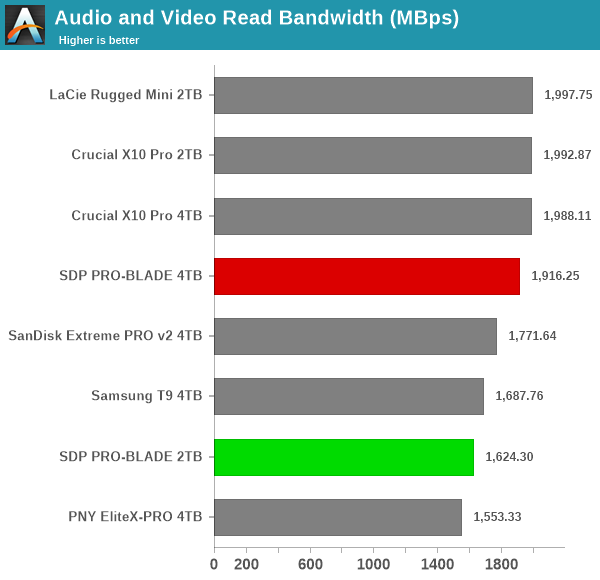
It can be seen that there is no significant gulf in the numbers between the different units. The PRO-BLADE TRANSPORT configurations come out on top in a lot of the benchmarks, and the SanDisk Extreme PRO v2 in others. In workload components where neither are on top, the numbers for the PSSD on top are within the run-to-run variations seen for the TRANSPORT configurations. For all practical purposes, the casual user will notice no difference between the different bridge-based PSSDs in the course of normal usage. However, power users may want to dig deeper to understand the limits of each device. To address this concern, we also instrumented our evaluation scheme for determining performance consistency.
Performance Consistency
Aspects influencing the performance consistency include SLC caching and thermal throttling / firmware caps on access rates to avoid overheating. This is important for power users, as the last thing that they want to see when copying over 100s of GB of data is the transfer rate going down to USB 2.0 speeds.
In addition to tracking the instantaneous read and write speeds of the DAS when processing the AnandTech DAS Suite, the temperature of the drive was also recorded. In earlier reviews, we used to track the temperature all through. However, we have observed that SMART read-outs for the temperature in NVMe SSDs using USB 3.2 Gen 2 bridge chips end up negatively affecting the actual transfer rates. To avoid this problem, we have restricted ourselves to recording the temperature only during the idling intervals. The graphs below present the recorded data.
| AnandTech DAS Suite – Performance Consistency | |
| TOP: | BOTTOM: |
 |
|
 |
|
The first three sets of writes and reads correspond to the AV suite. A small gap (for the transfer of the video suite from the internal SSD to the RAM drive) is followed by three sets for the Home suite. Another small RAM-drive transfer gap is followed by three sets for the Blu-ray folder. This is followed up with the large-sized ISO files set. Finally, we have the single disk-to-disk transfer set. Both TRANSPORT configurations are able to sustain a minimum of 1500 MBps across all write components – something that none of the other PSSDs in the competition set was able to do (the SanDisk Extrem PRO v2 included). The maximum recorded temperature was only 51C for the 4TB version and 49C for the 2TB one.
There are a number of storage benchmarks that can subject a device to artificial access traces by varying the mix of reads and writes, the access block sizes, and the queue depth / number of outstanding data requests. We saw results from two popular ones – ATTO, and CrystalDiskMark – in a previous section. More serious benchmarks, however, actually replicate access traces from real-world workloads to determine the suitability of a particular device for a particular workload. Real-world access traces may be used for simulating the behavior of computing activities that are limited by storage performance. Examples include booting an operating system or loading a particular game from the disk.
PCMark 10’s storage bench (introduced in v2.1.2153) includes four storage benchmarks that use relevant real-world traces from popular applications and common tasks to fully test the performance of the latest modern drives:
- The Full System Drive Benchmark uses a wide-ranging set of real-world traces from popular applications and common tasks to fully test the performance of the fastest modern drives. It involves a total of 204 GB of write traffic.
- The Quick System Drive Benchmark is a shorter test with a smaller set of less demanding real-world traces. It subjects the device to 23 GB of writes.
- The Data Drive Benchmark is designed to test drives that are used for storing files rather than applications. These typically include NAS drives, USB sticks, memory cards, and other external storage devices. The device is subjected to 15 GB of writes.
- The Drive Performance Consistency Test is a long-running and extremely demanding test with a heavy, continuous load for expert users. In-depth reporting shows how the performance of the drive varies under different conditions. This writes more than 23 TB of data to the drive.
Despite the data drive benchmark appearing most suitable for testing direct-attached storage, we opt to run the full system drive benchmark as part of our evaluation flow. Many of us use portable flash drives as boot drives and storage for Steam games. These types of use-cases are addressed only in the full system drive benchmark.
The Full System Drive Benchmark comprises of 23 different traces. For the purpose of presenting results, we classify them under five different categories:
- Boot: Replay of storage access trace recorded while booting Windows 10
- Creative: Replay of storage access traces recorded during the start up and usage of Adobe applications such as Acrobat, After Effects, Illustrator, Premiere Pro, Lightroom, and Photoshop.
- Office: Replay of storage access traces recorded during the usage of Microsoft Office applications such as Excel and Powerpoint.
- Gaming: Replay of storage access traces recorded during the start up of games such as Battlefield V, Call of Duty Black Ops 4, and Overwatch.
- File Transfers: Replay of storage access traces (Write-Only, Read-Write, and Read-Only) recorded during the transfer of data such as ISOs and photographs.
PCMark 10 also generates an overall score, bandwidth, and average latency number for quick comparison of different drives. The sub-sections in the rest of the page reference the access traces specified in the PCMark 10 Technical Guide.
Booting Windows 10
The read-write bandwidth recorded for each drive in the boo (that is the tag given in the official PCMark technical guide) access trace is presented below.

PSSDs using DRAM for the FTL usually perform better in workloads involving large number of random small-sized accesses like OS booting. So, it is no surprise that the TRANSPORT configurations along with the SanDisk Extreme PRO v2 take up the top three spots.
Creative Workloads
The read-write bandwidth recorded for each drive in the sacr, saft, sill, spre, slig, sps, aft, exc, ill, ind, psh, and psl access traces are presented below.
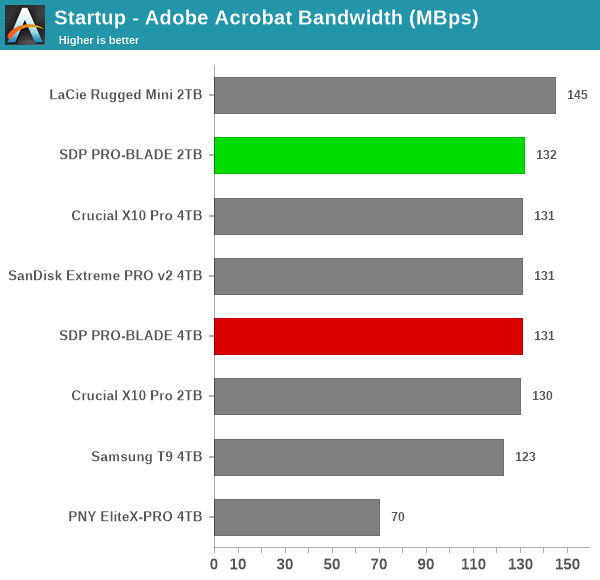
The LaCie Rugged Mini (despite its native UFD design) has its firmware optimized for certain creative workloads and comes out on top in a few. For the vast majority of the components, the three DRAM-enabled PSSDs take up the three top spots.
Office Workloads
The read-write bandwidth recorded for each drive in the exc and pow access traces are presented below.
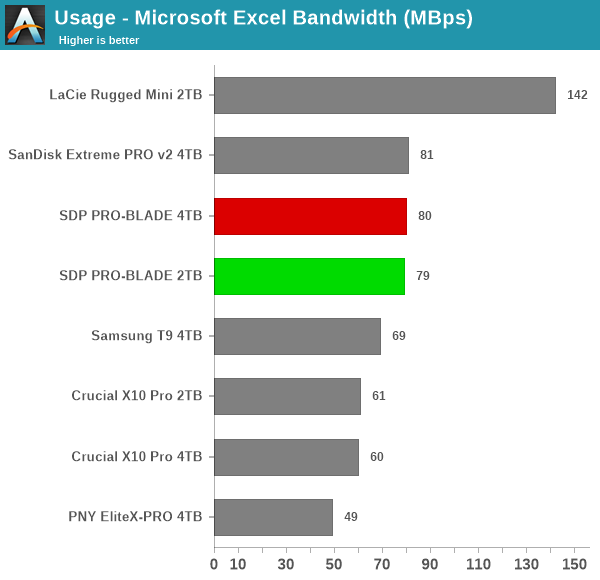
The Rugged Mini is on top for spreadsheet workloads, but the slides components sees the DRAM-enabled PSSDs from Western Digital taking up the top spots.
Gaming Workloads
The read-write bandwidth recorded for each drive in the bf, cod, and ow access traces are presented below.
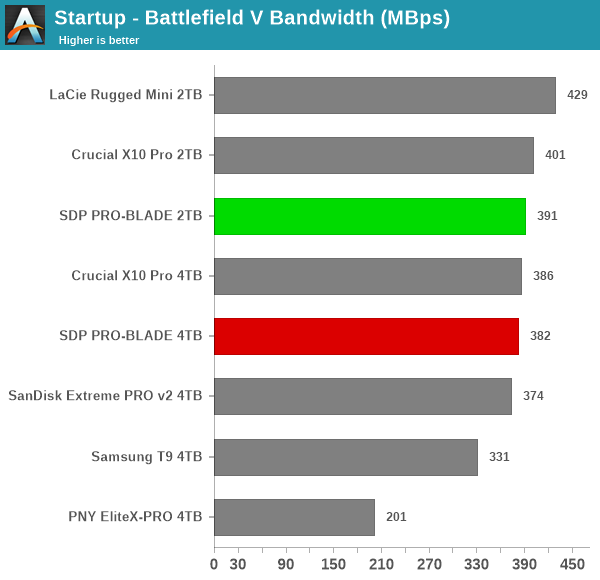
Gaming workloads are read-heavy and deal mostly with large-sized files. Under such conditions, most of the considered PSSDs that are able to saturate the 20 Gbps bus in the artificial tests perform similarly.
Files Transfer Workloads
The read-write bandwidth recorded for each drive in the cp1, cp2, cp3, cps1, cps2, and cps3 access traces are presented below.
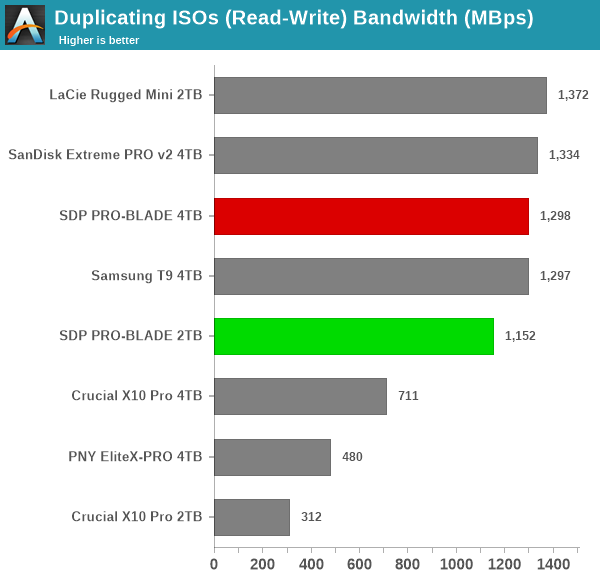
The results in these are largely reflective of what was observed in the AnandTech DAS Suite, and the same analysis holds true here with different PSSDs trading places for different components. The DRAM-enabled PSSDs hold a slight edge across the board.
Overall Scores
PCMark 10 reports an overall score based on the observed bandwidth and access times for the full workload set. The score, bandwidth, and average access latency for each of the drives are presented below.
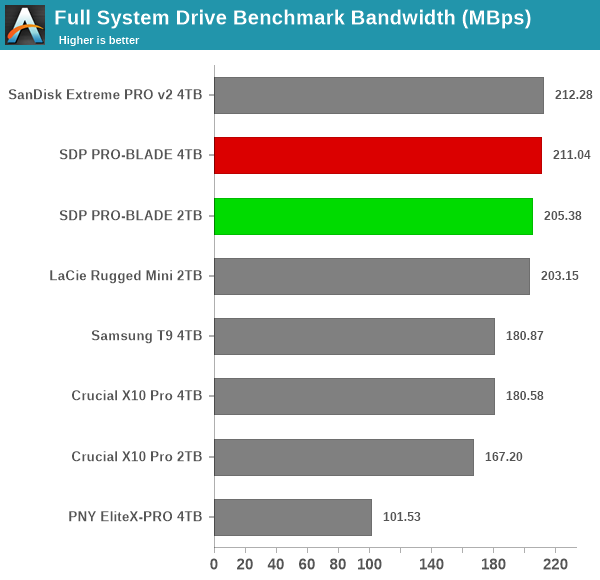
It is no surprise that the three PSSDs incorporating a NVMe SSD using DRAM for the flash translation layer take up the top three spots, and there is not much separating them in terms of either bandwidth or latency.
The performance of the PRO-BLADE TRANSPORT 2TB and 4TB versions in various real-world access traces as well as synthetic workloads was brought out in the preceding sections. We also looked at the performance consistency for these cases. Power users may also be interested in performance consistency under worst-case conditions, as well as drive power consumption. The latter is also important when used with battery powered devices such as notebooks and cameras. Pricing is also a relevant aspect. We analyze each of these in detail below.
Worst-Case Performance Consistency
Flash-based storage devices tend to slow down in unpredictable ways when subject to a large number of small-sized random writes. Many benchmarks use that scheme to pre-condition devices prior to the actual testing in order to get a worst-case representative number. Fortunately, such workloads are uncommon for direct-attached storage devices, where workloads are largely sequential in nature. Use of SLC caching as well as firmware caps to prevent overheating may cause drop in write speeds when a flash-based DAS device is subject to sustained sequential writes.
Our Sequential Writes Performance Consistency Test configures the device as a raw physical disk (after deleting configured volumes). A fio workload is set up to write sequential data to the raw drive with a block size of 128K and iodepth of 32 to cover 90% of the drive capacity. The internal temperature is recorded at either end of the workload, while the instantaneous write data rate and cumulative total write data amount are recorded at 1-second intervals.
| Sequential Writes to 90% Capacity – Performance Consistency | |
| TOP: | BOTTOM: |
 |
|
 |
|
The 4TB version can write around 60GB at 1.8 GBps+ before moving to a direct to TLC write speed of 1.6 GBps. On the other hand, the 2TB version can write around 28GB at 1.8 GBps+ before settling down to 1.5 GBps for the rest of the workload. Temperatures end up at 56C and 52C for the two variants. The performance profile of the 4TB variant matches that of the SanDisk Extreme PRO v2 of the same capacity. The Crucial X10 Pro 4TB is able to maintain 1.6 GBps throughout, but it doesn’t have the initial 1.8 GBps+ burst. Other PSSDs suffer from significant performance loss in the duration of the test. Overall, this performance profile is ideal for sustained heavy write workloads seen in the content capture industry.
Power Consumption
Bus-powered devices can configure themselves to operate within the power delivery constraints of the host port. While Thunderbolt ports are guaranteed to supply up to 15W for client devices, USB 2.0 ports are guaranteed to deliver only 2.5W (500mA @ 5V). In this context, it is interesting to have a fine-grained look at the power consumption profile of the various external drives. Using the ChargerLAB KM003C, the bus power consumption of the drives was tracked while processing the CrystalDiskMark workloads (separated by 5s intervals). The graphs below plot the instantaneous bus power consumption against time, while singling out the maximum and minimum power consumption numbers.
| CrystalDiskMark Workloads – Power Consumption | |
| TOP: | BOTTOM: |
 |
|
 |
|
The 4TB version has a peak power consumption of 9.58 W, while the 2TB one peaks at 8.26 W. Fortunately, there is an idling mode for both where the power consumption drops to 0.34 W. Bridge-based solutions incorporating SSDs with DRAM are expected to be power hungry, and the PRO-BLADE TRANSPORT configurations are no exception. Fortunately, the devices provide excellent performance consistency to go along with this power profile.
Final Words
The PRO-BLADE TRANSPORT 4TB is currently available for $340 and the 2TB version is available for $220. These prices have only a very slight premium compared to the other PSSDs in the comparison graphs and tables. The difference ranges from $10 to $50 depending on the capacity and model, with the PRO-BLADE ones understandably on the costlier side. For businesses and professional users, it is a no-brainer to opt for the PRO-BLADE units with its performance consistency across both workload types and sustained usage.
Based on the evaluation of different portable SSDs and the current pricing, it is clear that the performance of the PRO-BLADE SSD Mag / TRANSPORT is very compelling. The thermal design is top notch, and the value proposition is excellent for professional users. Casual users and even prosumers may probably be better served by cheaper PSSDs that are more power efficient.
Some users may be wary of the history associated with the SanDisk Extreme PRO v2 PSSDs given the platform similarity of the PRO-BLADE TRANSPORT / SSD Mag to it. Our sample size of four SSD Mags and two TRANSPORT enclosures is small, but we encountered no issues despite subjecting the mags to 10TB+ of traffic each. For peace of mind (and most professional users already know this), it is always recommended to not store the sole copy of a particular piece of data on one device only (and that includes PSSDs like the PRO-BLADE units too).







